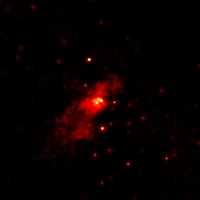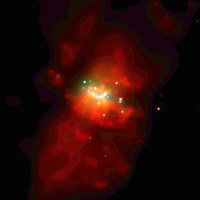June 5, 2001, 11:15 am PDT
NASA's Chandra X-ray Observatory has found new populations of suspected mid-mass black holes in several starburst galaxies, where stars form and explode at an unusually high rate. Although a few of these objects had been found previously, this is the first time they have been detected in such large numbers and could help explain their relationship to star formation and the production of even more massive black holes.
At the 198th meeting of the American Astronomical Society in Pasadena, California, three independent teams of scientists reported finding dozens of X-ray sources in galaxies aglow with star formation. These X-ray objects appear point-like and are ten to a thousand times more luminous in X-rays than similar sources found in our Milky Way and the M81 galaxy.
"Chandra gives us the ability to study the populations of individual bright X-ray sources in nearby galaxies in extraordinary detail," said Andreas Zezas, lead author from the Harvard-Smithsonian Center for Astrophysics team that observed The Antennae, a pair of colliding galaxies, and M82, a well-known starburst galaxy. "This allows us to build on earlier detections of these objects and better understand their relationship to starburst galaxies."
Kimberly Weaver, of NASA's Goddard Space Flight Center in Greenbelt, MD, lead scientist of the team that studied the starburst galaxy NGC 253, discussed the importance of the unusual concentration of these very luminous X-ray sources near the center of that galaxy. Four sources, which are tens to thousands of times more massive than the Sun, are located within 3,000 light years of the galaxy core.
"This may imply that these black holes are gravitating toward the center of the galaxy where they could coalesce to form a single supermassive black hole," Weaver suggested. "It could be that this starburst galaxy is transforming itself into a quasar-like galaxy as we watch. In NGC 253, Chandra may have found the causal connection between starburst activity and quasars."
Chandra detected variability and a relatively large ratio of high- to low-energy X-rays in these sources – two characteristics of superheated gas falling into black holes. When combined with extreme luminosities, this tells astronomers that some of these objects must have masses many times greater than ordinary stellar black holes, if they radiate energy uniformly in all directions.
Scenarios for the formation of such "intermediate-mass" black holes include the direct collapse of a single, massive cloud of gas into a black hole, or the coalescence of a cluster of stellar black holes, but no uniformly accepted model exists.
An alternative possibility, mentioned by Giuseppina Fabbiano of the Harvard-Smithsonian team, is that the X-rays from such highly luminous sources are beamed toward us -- perhaps by a funnel formed by the infalling matter. This would imply that the mass of the underlying black hole is only about ten times the mass of the Sun, in line with the known black hole sources in our galaxy. In this event, they would represent a short-lived but common stage in the evolution of black holes in close binary star systems. Long-term monitoring of the very luminous X-ray sources should distinguish between these possibilities.
Andrew Ptak, led a team from Carnegie-Mellon University in Pittsburgh, PA, and Penn State University, University Park, PA, that used Chandra data to survey 37 galaxies. Ptak’s team found that 25 percent of galaxies, which were chosen for their suspected central supermassive black holes and areas of star formation, had these very luminous X-ray sources. The team plans to expand their survey with Chandra to assess the probability of finding these very bright X-ray sources in other types of galaxies.
NASA's Marshall Space Flight Center, Huntsville, AL, manages the Chandra program for the Office of Space Science, Washington, DC. TRW, Inc., Redondo Beach, California, is the prime contractor for the spacecraft. The Smithsonian's Chandra X-ray Center controls science and flight operations from Cambridge, MA.
Images associated with this release are available on the World Wide Web at:
MEDIA CONTACTS
Dolores Beasley
Headquarters, Washington, DC
Phone: 202/358-1753
Steve Roy
Marshall Space Flight Center, Huntsville, AL
Phone: 256-544-6535
Megan Watzke
Chandra X-ray Observatory Center, CfA, Cambridge, MA
Phone: 617-496-7998





